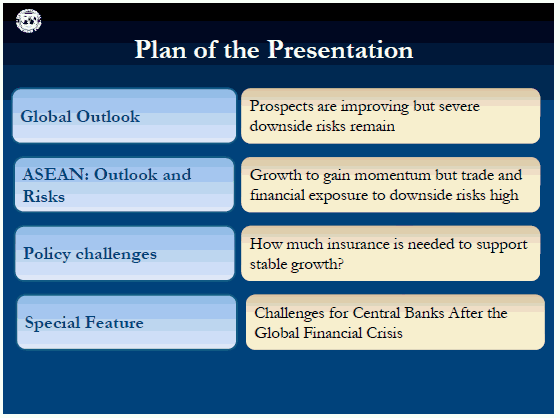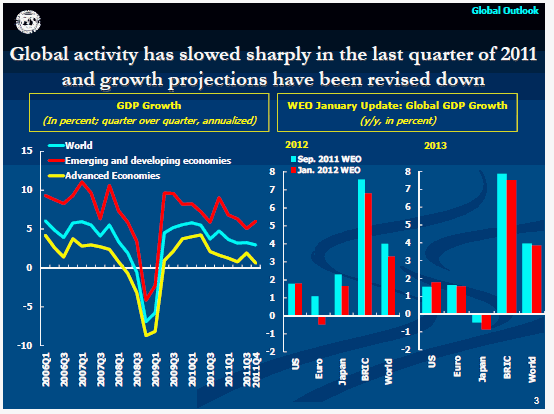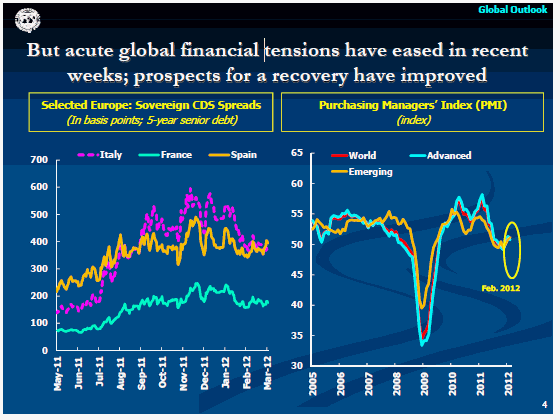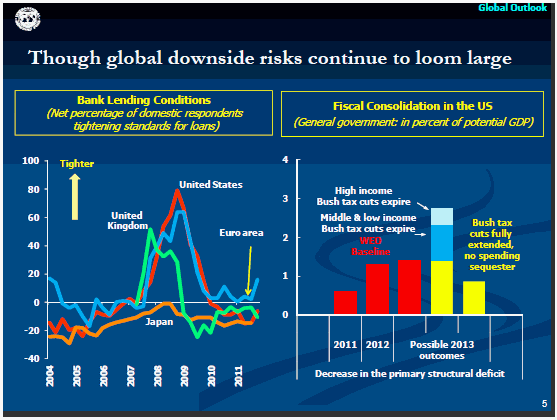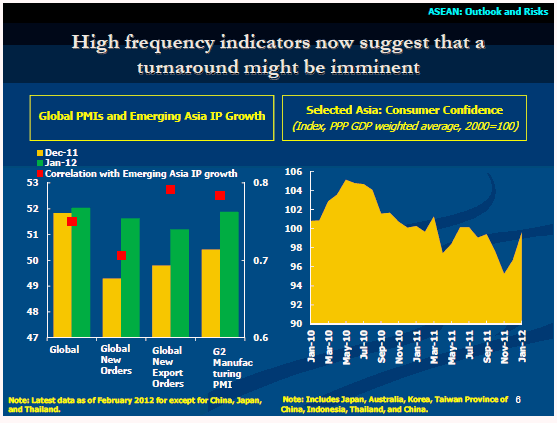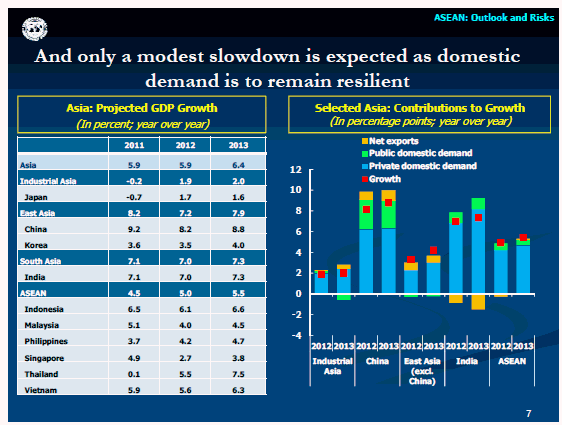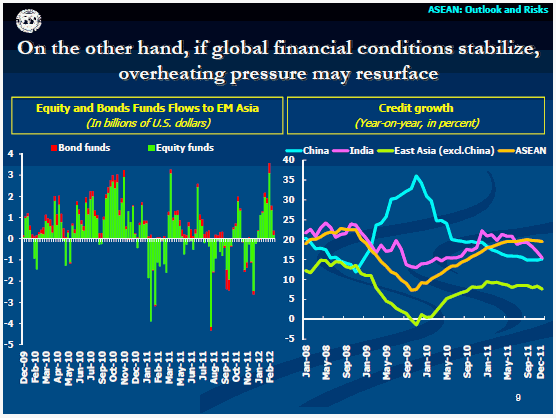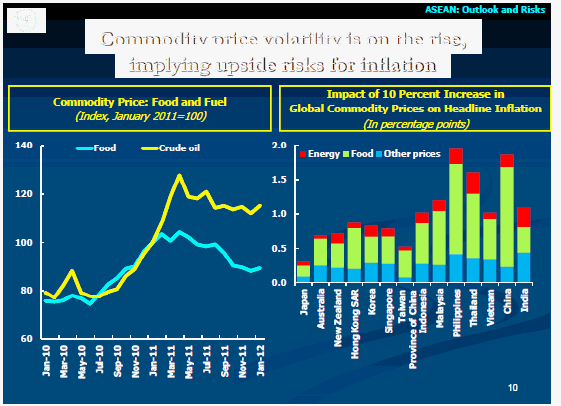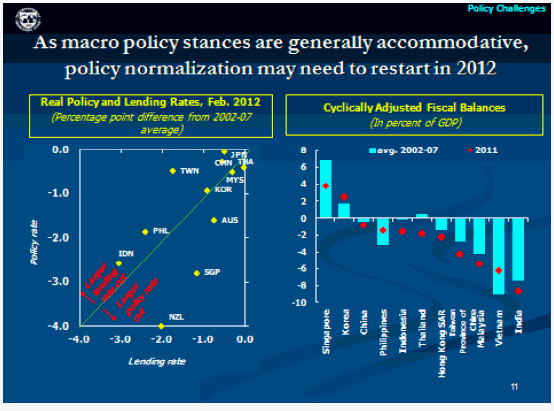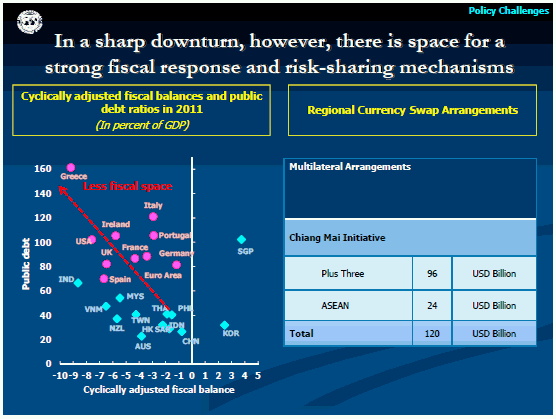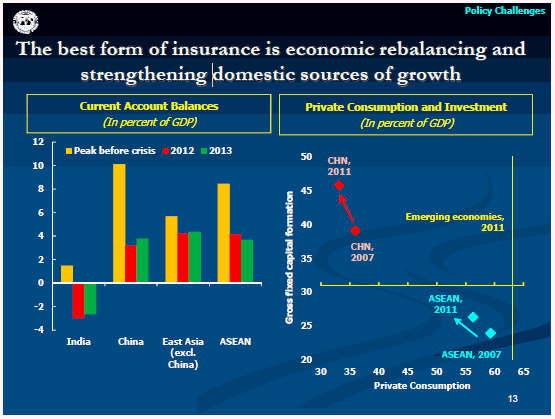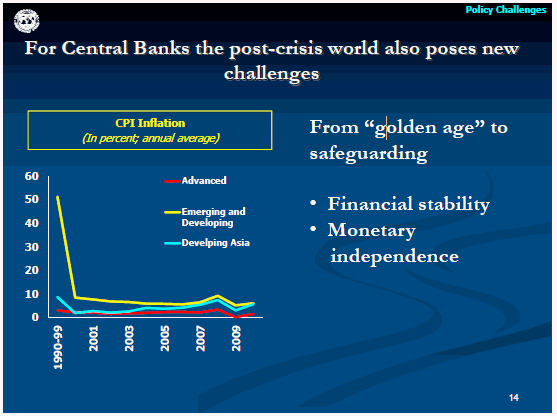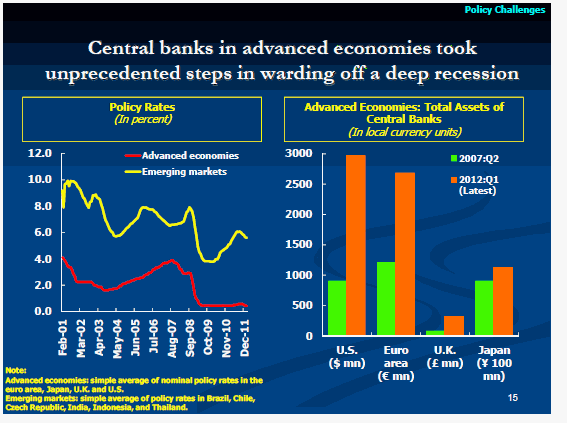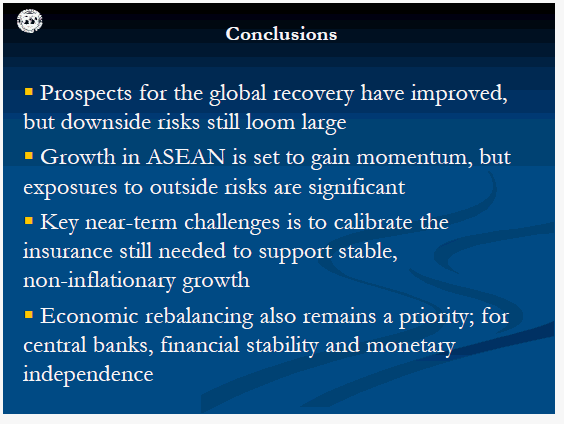"Global and Regional Economic Outlook and Challenges for Central Banks after the Global Financial Crisis", Presentation at the 8th ASEAN Central Bank Governors’ Meeting by Naoyuki Shinohara, IMF Deputy Managing Director, March 29, 2012
March 29, 2012
Presentation at the 8th ASEAN Central Bank Governors’ MeetingNaoyuki Shinohara, IMF Deputy Managing Director
March 29, 2012
As prepared for delivery
1. Good morning. It is a pleasure to be once again in Cambodia and a real privilege to give a presentation to our friends and colleagues at the ASEAN Central Bank Governors’ Meeting.
2. In my talk today, I would like to cover four broad topics. After discussing briefly the global economic setting, I will focus on the outlook, risks and policy challenges for economies in the Asia and Pacific region. The major near- and medium-term challenge for central banks in ASEAN economies has to do with calibrating the right amount of insurance still needed to support stable, non-inflationary growth. But there are also important longer-term challenges that need to be addressed. I will discuss two of these, financial stability and monetary independence, in the final part of my presentation.
3. Let me begin by saying a few words about the global economy.
4. The global economy has gone through very difficult times in recent years, and late last year economic indicators pointed to a sharp setback of the global recovery. But in recent weeks, some positive signs have emerged, including in the United States. Important policy actions, particularly by European policymakers, have helped. More recently, the agreement on a new program for Greece has also brought some relief and it will be important to implement all the agreed actions.
5. Because of all these efforts, the world economy has avoided extremely disruptive outcomes. But there is no room for complacency. A lot more needs to be done to give a fresh boost to growth. The repair of financial systems still has a long way to go. Public debt in many countries remains at all-time highs, constraining policy actions. Unemployment also remains high in many countries. And oil price increases present a real risk. In short, we are navigating a very narrow path to full recovery, and the risk of slippage is very high. To stay the course on that narrow path, everyone has a job to do.
- Advanced economies should use macroeconomic policies to support the recovery if they have the space to do so, and should press ahead with financial and structural reforms to repair the damage done by the crisis.
- And emerging economies need to stay vigilant from possible spillovers from the advanced economies while keeping overheating pressures in check where applicable.
- All countries need to make clear efforts to translate higher growth into better living standards for all.
6. Let me go a little more into the details of the outlook. As I said before, the global recovery suffered a major setback in late 2011. The sovereign debt crisis in Europe sent sovereign bond rates to unprecedented levels and business and consumer confidence collapsed. Adverse spillovers affected emerging market economies, but other factors, including policy tightening in emerging Asia and Latin America and social unrest in the Middle East, also took a toll on growth. In the United States, however, credit and labor markets began to show signs of life with consumption and inventory adjustments supporting growth.
7. Reflecting these developments, our latest projections (published in January) point to a small decline in global growth this year compared to 2011. Growth performance in the United States should compare favorably with that of the euro area, where we expect a mild contraction. We are in the process of revising our forecast and will publish new numbers in April, but we continue to expect that the euro area crisis will be contained so that adverse spillovers to other regions will remain limited.
8. In fact, acute financial tensions in the euro area have eased in recent weeks, in large part thanks to the ECB’s 3-year long-term refinancing operations. High frequency economic indicators such as PMI indices reflect these improvements.
9. But the situation is very fragile and, ith important policy challenges that remain to be addressed, downside risks are large. The most immediate concern is still that the euro area crisis may escalate further. To avoid this risk, European policymakers need to pursue fiscal adjustment at the right pace—and this pace differs across countries; they also need to pursue financial reforms to stabilize the banking sector and structural reforms to restore competitiveness; and they need to increase the strength of their firewall to provide an adequate backstop for the governments undertaking these reforms.
10. Another risk is that political pressures could force an excessive policy tightening in advanced countries that still have room for accommodative policies, such as the US. Indeed the pace of the US fiscal consolidation in 2013 could range from below 1 percent of GDP to about 3 percent of GDP depending on whether there will be political agreement on deficit reduction and what the elements of such an agreement might be.
11. Closer to home, growth in Asia is also expected to regain momentum this year. Activity, across the region, slowed sharply in the fourth quarter of 2011 mainly due to external factors. In addition, natural disasters led to supply chain disruptions which significantly affected production. But domestic demand in emerging Asia has generally remained strong, supported by low unemployment, high capacity utilization, and robust credit growth. Recent leading economic indicators strengthened and capital flows to emerging Asia have rebounded earlier this year although they remain very fragile.
12. Against this background, and despite the moderation of growth in China, we expect growth in Asia this year to remain broadly in line with the 2011 outcome. Solid fundamentals for domestic demand, such as relatively strong employment, should support growth. In addition, continued capital inflows and reconstruction spending in some parts of Asia would spur private investment and consumption across the region.
13. But Asia is also exposed to the large downside risks facing the global economy. On a value-added basis, for many smaller open Asian economies more than 1/3 of GDP is linked to demand outside Asia, mostly from the traditional markets in the United States and Europe. A sharp fall in this demand, and a reversal of foreign capital flows, would severely impact activity in Asia.
14. So far the impact of the deleveraging process in the European Union has been limited. Indeed, relatively healthy balance sheets have allowed large regional banks to act as a buffer against a credit supply shock. In fact, credit growth has continued at double digit rates in the region and local bond markets have continued to expand.
15. Turning to inflation, we see risks from increasing oil prices given geopolitical tensions, the low global inventories and spare capacity.
16. Against this background, ASEAN policymakers face the difficult task of calibrating the amount of insurance needed to support stable, non inflationary growth.
17. On one hand, downside risks are still looming and policymakers need to remain vigilant as signs of renewed deterioration in external conditions may require easing policies in those countries that have the requisite policy space.
18. But with acute global risks receding earlier this year and signs that the slowdown is bottoming out in most of Asia in the first quarter, policymakers should also stand ready to return to more neutral macro policies. Of course, the balance of risks and the need for switching gears quickly differs from country to country.
19. That said, there is generally enough space in ASEAN economies to counter a sharp downturn in the event of renewed global turmoil, given lower public debt stocks relative to other regions. At the same time, another positive element is that regional risk-sharing mechanisms have been strengthened, particularly through currency swap arrangements.
20. For the medium term, strengthening domestic sources of growth is crucial. This is not happening enough yet. The recent decline of current account surpluses in Asia is cyclical in part and reflects weaker external demand. Moreover, for China, the sharp decline in the current account surplus also reflects a secular deterioration in terms of trade and perhaps also a saturation of export markets given China’s already high market share.
21. For China in particular, imbalances seem to have shifted from the current account to the domestic economy. Excessively low consumption has weakened further since the beginning of the global crisis, and domestic demand has been driven by strong investment instead, raising concerns about excess capacity and bank balance sheets.
22. Let me now turn to some of the more fundamental challenges that central banks face in the wake of the global crisis.
23. For about twenty years prior to the crisis, central banks enjoyed a “golden age”. With the support of strong institutional foundations, central banks built a solid monetary policy framework, often based on inflation targeting. The world witnessed a prolonged period of low inflation and higher economic growth.
24. When the global financial crisis erupted, central banks emerged as a main protagonist of the policy response. Fiscal policy was initially able to play a countercyclical role, but it was soon constrained by high public debt levels. Thus, monetary policy was called to action, in particular in advanced economies. Central banks lowered interest rates close to zero and expanded their balance sheets through unconventional policies. Without these steps, the costs of the crisis would have been much higher, with a deeper recession and further deterioration of private and public balance sheets. In developing and emerging market countries, central banks also played a crucial function: they eased liquidity conditions to counter the impact of capital flight following the collapse of Lehman Brothers.
25. In the aftermath of the crisis, central banks’ responsibilities are bound to change. Two critical challenges lie ahead. First, central banks may need to play a critical role in the design and implementation of macroprudential policy. Second, they face the difficult task of preserving the effectiveness of monetary policy in the face of potential fiscal dominance.
Macroprudential policies
26. Today, there is increasing recognition that gaps in the macroprudential framework allowed financial vulnerabilities to grow unchecked. System-wide risks increased over time and led to the global financial crisis. To prevent such a costly crisis from happening again, many countries are revisiting their institutional foundations. Because of the nature of the crisis, central banks had to play a critical role in the design and implementation of macroprudential policy. For example, new institutional arrangements were introduced in the United Kingdom, Ireland and, in Asia, Thailand and Malaysia where the central bank chairs the committee in charge of macroprudential policy. While there is debate about the meaning of macroprudential policy, there is growing convergence around the view that it is a policy that uses primarily prudential tools to limit systemic risks—that is the possibility of a major disruption of financial systems that may have a material adverse impact on economic activity.
27. A key question is how to shape the conduct of macroprudential policy, and what institutional arrangements to put in place. There is no clearcut answer, although a stronger role for central banks seems desirable.
28. Central banks are well positioned to shape the conduct of macroprudential policymaking. First, given its counter-cyclical nature, macroprudential policy is subject to adverse political economy influence. Thus, macroprudential policy making should take place in an environment of political independence and with long-term horizons. Both conditions typically support central banks’ monetary policy decisions. Second, central banks can contribute to macroprudential policy their expertise in the analysis of systemic risks given their pivotal roles in the financial system. Third, central banks have a wealth of experience communicating complex risks to the markets and the general public.
29. But involving central banks in macroprudential policy also carries potential difficulties. This is because the interrelationship between macroprudential and monetary policies is not well understood and is often country-specific. In particular, what is the impact of monetary policy decisions on financial stability? What are the transmission channels through which monetary policy affects financial sector behavior, private sector balance sheets, and the real sector? We are not yet able to provide conclusive answers to these questions. And we should not expect one-size-fits-all answers, because they might hinge on specific country characteristics such as the structure of the financial system, exposures to domestic and external risks, or the exchange rate regime.
Fiscal dominance and the independence of monetary policy
30. A second important challenge facing central banks, especially in advanced countries, is conducting monetary policy in the presence of a large public debt. With a gross debt to GDP of around 80 percent in most of the G7 economies—and much more in countries like Italy and Japan— the required fiscal adjustment to bring debt to more sustainable levels and deal with fiscal pressures from aging populations may pose significant challenges.
31. In an environment of fiscal consolidation, the onus of stimulating aggregate demand falls on monetary policy. In normal circumstances, the typical monetary policy response is to lower short term interest rates. But the effectiveness of this response is limited when interest rates are already very low. This is why central banks engaged in unconventional measures and expanded their balance sheets in response to the global crisis. Overall, such measures seem to be relatively successful, but their efficiency depends on domestic circumstances, such as risk premia and the strength of central bank balance sheets.
32. In coping with these new challenges policymakers need to avoid undermining the hard-won independence of monetary policy. The roles of the central bank, government and other entities need to be preserved and clearly delineated. Central banks need to remain an anchor of macroeconomic stability as independent but accountable institutions.
33. In sum, let me say that while prospects for the global recovery have improved in recent weeks, significant risks remain. Growth in ASEAN is also set to regain momentum, but policy makers face difficult challenges as the balance of risks remains highly uncertain. Providing the right amount of insurance in support of stable growth is not only the key near-term challenge. Comprehensive macroeconomic and structural reform policies are needed to bring about lasting economic rebalancing. For central banks, safeguarding financial stability and monetary independence will remain high on the agenda.
IMF EXTERNAL RELATIONS DEPARTMENT
| Public Affairs | Media Relations | |||
|---|---|---|---|---|
| E-mail: | publicaffairs@imf.org | E-mail: | media@imf.org | |
| Fax: | 202-623-6220 | Phone: | 202-623-7100 | |








